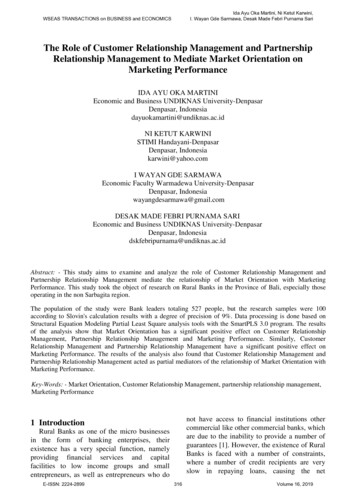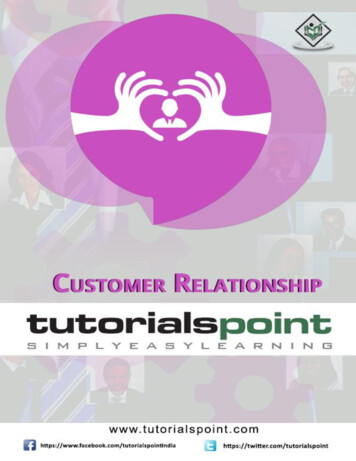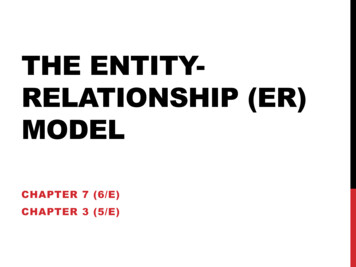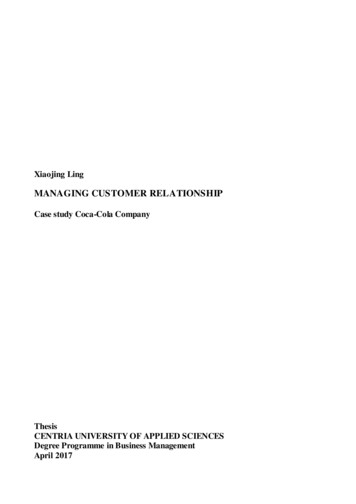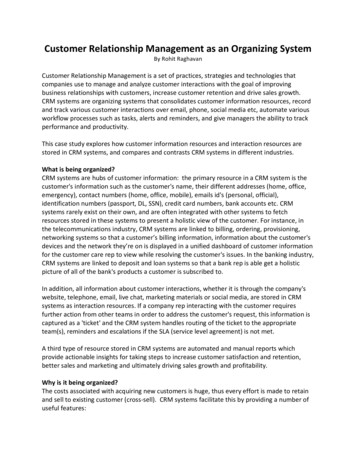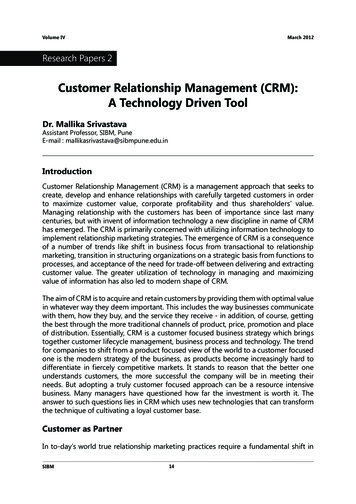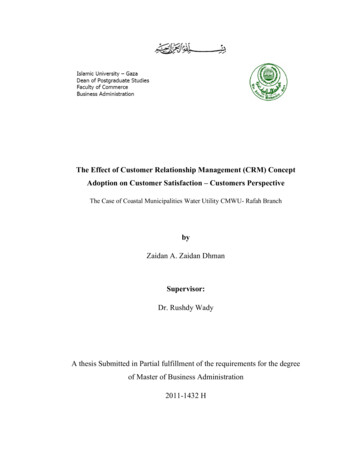
Transcription
The Effect of Customer Relationship Management (CRM) ConceptAdoption on Customer Satisfaction – Customers PerspectiveThe Case of Coastal Municipalities Water Utility CMWU- Rafah BranchbyZaidan A. Zaidan DhmanSupervisor:Dr. Rushdy WadyA thesis Submitted in Partial fulfillment of the requirements for the degreeof Master of Business Administration2011-1432 H
أﻋﻮذ ﺑﺎﷲ ﻣﻦ اﻟﺸﻴﻄﺎن اﻟﺮﺟﻴﻢ " ﻗﻞ إن ﺻﻼﺗﻲ و ﻧﺴﻜﻲ و ﻣﺤﻴﺎي و ﻣﻤﺎﺗﻲ ﷲ رب اﻟﻌﺎﻟﻤﻴﻦ ، ﻻ ﺷﺮﻳﻚ ﻟﻪ و ﺑﺬﻟﻚ أﻣﺮت و أﻧﺎ أول اﻟﻤﺴﻠﻤﻴﻦ " ﺻﺪق اﷲ اﻟﻌﻈﻴﻢ اﻷﻧﻌﺎم 163 - 162
I
DEDICATIONI dedicate my study to my Father, to my Grandmother & to my BrotherMotaz - God's mercy be upon them, for which their memories give methe energy to continue.I dedicate my study to my Mother for whom words is not enough toexpress my gratitude’s.I dedicate my study to my wife, my daughter Elena, and my sons Yamenand Momen.I dedicate my study to who encourages me to accomplish my study, allmy family members, my friends, and my colleagues in costalmunicipalities water utility CMWU.Finally I dedicate my study to my beloved Palestine and all the martyrswho sacrificed for the sake of independence and freedom.II
ACKNOWLEDGMENTSI would like to express my deepest appreciation to Dr. Rushdy A. Wady, for providingexcellent guidance, generous supports, and continuous encouragements throughout myresearch. His suggestions and comments were of great value in writing of this study.I would also like to thank Professor. Majed El Farra dean of faculty of commerce and Dr. SamiAbu El Roos for their endless effort in the discussion of this study.My sincere appreciation to Dr. Samir Safi who statistically analyzed this study and providedme with valuable advice.My sincere appreciation to my colleagues in CMWU - customer services departmentespecially Mr. Esmael Jaber for his efforts in distributing and collecting the questionnaires.I would also like to thank the Faculty of Commerce for all of their support and feedbackduring my study.III
TABLE OF CONTENTSDEDICATION IACKNOWLEDGMENTS IIITABLE OF CONTENTS IVLIST OF TABLES VILIST OF FIGURES VIILIST OF ABBREVIATIONS VIIIABSTRACT IX ﻣﻠﺨﺺ اﻟﺪراﺳﺔ ﺑﺎﻟﻠﻐﺔ اﻟﻌﺮﺑﻴﺔ X1CHAPTER 1: INTRODUCTION 11.11.21.31.41.51.5.11.5.21.61.72Introduction . 2Background . 2Research Problem . 4Study Hypothesis . 5The study variables . 5Independent variables: . 5Dependent variables: . 5Research Objectives. 6Importance of the Study . 6CHAPTER 2: LITERATURE REVIEW AND PERVIOUS STUDIES 72.1 Introduction . 82.2 Rise of relationship marketing . 92.3 Customer Relationship Management - CRM . 112.3.1 Why CRM Is Valuable . 162.4 Customer Satisfaction . 162.5 Customer acquisition . 202.6 Customer Retention . 222.6.1 Why retention improvement is important to CMWU. . 232.6.2 A frame work for customer retention improvement to CMWU. . 232.7 Customer Loss Rate . 242.8 CRM Ingredients . 252.8.1 People. 262.8.2 Process . 282.8.3 Technology . 302.9 CRM Models . 312.10 Factors that affect CRM successful implementation . 342.11 CRM in the public sector . 352.11.1 What prevent effective public sector CRM . 372.11.2 CRM in the public sector Vs CRM in the private sector. 392.12 Introduction to CMWU . 402.12.1 First- establishment steps of the Water Utility: Legal Stage . 402.12.2 Second: Contracting stage . 412.12.3 Third: CMWU administrated by Local staff . 422.12.4 Final Stage: Assets and employees transfer . 42IV
2.13 CRM in water services Utility . 422.13.1 Conditions that could impede a successful implementation of CRM in CMWU. 452.14 Previous studies . 472.14.1 Local Studies: . 482.14.2 Foreign Studies:. 512.14.3 Comments on Previous studies . 733CHAPTER 3: RESEARCH METHODOLOGY .153.163.17Introduction . 77Study Design . 77Population and sample . 78Inclusion and Exclusion Criteria . 80Questionnaire Design and Preparation . 80Response Rate . 82Data Collection . 82Ethical Matter . 82Data Coding and Entry. 82Data Measurement. 83Statistical analysis Tools . 83Piloting . 84Validity of the Questionnaire . 85Statistical Validity of the Questionnaire . 85Internal Validity . 85Reliability of the Research. 85Cronbach’s Coefficient Alpha . 863.18Split Half Method . 863.19 Internal Validity . 863.20 Structure Validity . 913.21 Reliability Statistics . 914 CHAPTER 4: DATA ANALYSIS, INTERPRETAION AND HYPOTHESESTESTING 934.14.24.34.3.14.3.24.3.34.3.44.3.55Introduction . 94Descriptive Analysis of the Sample, Personal information . 94Hypothesis Testing . 97Testing of Hypothesis 1. 98Testing of Hypothesis 2. 107Testing Hypothesis 3 . 114Testing of Hypothesis 4. 121Testing of Hypothesis 5. 127CHAPTER 5: CONCLUSIONS AND RECOMMENDATIONS 1315.15.25.35.4Introduction . 132Conclusions . 132Recommendations . 139Recommendation for further studies: . 1426BIBLOGRAPHY 1437APPENDICES 148Appendix 1: list of Referees . 148Appendix 2: Questionnaire (English Version) . 149Appendix 3: Questionnaire (Arabic Version) . 154V
LIST OF TABLESTable 2.1: Differences between CRM in private sector/CRM in the public sector.(Saremi 2009) . 39Table 3.1: No of customers / Area. CMWU billing record. . 78Table 3.2: customer’s classification in area no.5 CMWU billing Record . 79Table 3.3: Response rate according to customer classification . 82Table 3.4: Likert scale . 83Table 3.5: Correlation coefficient of each item of customers Satisfaction measure and the total of thisfield . 87Table 3.6: Correlation coefficient of each item of customer’s acquisition measure and the total of thisfield . 88Table 3.7: Correlation coefficient of each item of customer’s retention measure and the total of thisfield . 89Table 3.8: Correlation coefficient of each item of customer’s loss measure and the total of this field90Table 3.9: Correlation coefficient of each field and the whole of questionnaire . 91Table 3.10: Cronbach's Alpha for each filed of the questionnaire and the entire questionnaire . 91Table 3.11: Split Half Method . 92Table 4.1: Customers’ Age Frequency Outcomes. . 94Table 4.2: Educational attainments . 94Table 4.3: Monthly income / NIS . 95Table 4.4: how often you pay the water bill. . 95Table 4.5: paying the bill occurs through . 96Table 4.6: Visiting CMWU customer services office. 96Table 4.7: Visiting CMWU customer services website. 97Table 4.8: Analysis methodology for research hypothesis according to customer’s classification. . 97Table 4.9 : Analysis results for customer satisfaction measure – CC. 98Table 4.10: Analysis results for customer satisfaction measure – PCC. . 100Table 4.11: Analysis results for customer satisfaction measure – UCC. . 102Table 4.12: Customer satisfaction measure for all the customers (CC PCC UCC). . 104Table 4.13: Means and Test values for Customer’s acquisition measure – PCC . 107Table 4.14: Means and Test values for “Customer’s acquisition measure” - UCC . 109Table 4.15: Customer acquisition measure for PCC & UCC. . 111Table 4.16: Means and Test values for “Customer’s retention measure”- CC . 114Table 4.17: Means and Test values for Customer’s retention measure - PCC . 116Table 4.18: Customer retention measure for CC & PCC. . 118Table 4.19: Means and Test values for “Customer’s loss measure” - CC . 121Table 4.20: Means and Test values for “Customer’s loss measure” - PCC. 123Table 4.21: Customer loss measure for CC & PCC. . 125Table 4.22: Kruskal-Wallis Test of the fields and their p-values for age . 127Table 4.23: Means for each field of age . 128Table 4.24: Kruskal-Wallis Test of the fields and their p-values for educational attainment . 129Table 4.25: Means for each field of educational level. 129Table 4.26: Kruskal-Wallis Test of the fields and their p-values for standard of living . 130Table 4.27: Means for each field of standard of living. 130VI
LIST OF FIGURESFigure 1.1: The Study Variables. (conceptualized by the researcher) . 5Figure 2.1: The evolution of Marketing (Sharp 2003). 10Figure 2.2: The CRM continuum, Payne & Frow 2005 . 12Figure 2.3: Customer satisfaction, loyalty and business performance (Buttle 2004) . 19Figure 2.4: A CRM implementation Model. Chen & Povich 2007. . 26Figure 2.5: Changing Marketing Strategy. (Chen & Popovich 2003) . 30Figure 2.6: CRM Model: Quaero 1999. . 32Figure 2.7: International Data Consultancy CRM Model: the International Data Consultancy 199932Figure 2.8: PHS Management Training CRM Model: PHS Management Training Co.1999 . 34Figure 2.9: Positive Image Building Model. Kell 1993. 44Figure 3.1: Data Analysis flow chart.(conceptualized by the researcher) . 84Figure 5.1: CMWU – CRM model, conceptualized by the researcher. . 138VII
LIST OF CCCustomer AcquisitionCommitted CustomersCustomer Complaints StructureCustomer LossCoastal municipalities water utilityCustomer RetentionCustomer Relationship ManagementCustomer SatisfactionCitizen Relationship ManagementInformation technologyPartially Committed CustomersPalestinian Water AuthorityRelationship MarketingRelationship ShareUncommitted CustomersVIII
ABSTRACTThis study aims to investigate the effect of applying the concept of customer relationshipmanagement (CRM) on customer’s acquisition, satisfaction, retention and decreasingcustomer’s loss in the coastal municipalities water utility (CMWU) from customer’sperspectives. The city of Rafah was selected from 14 municipalities that CMWUadministrates.Delivery and collection questionnaire was used, and responses from 393 customers in thecity of Rafah were retrieved using stratified sampling. The customers were classifiedaccording to their commitment to pay their monthly water bills, and they were categorized into3 groups, the committed customers’ CC, the partially committed customers PCC and theuncommitted customers UCC. The study found that adopting CRM concept in the CMWU wassignificantly correlated in positive direction with reaching customer acquisition, satisfaction,retention and decreasing customer loss. Moreover, the study reveals that CRM has effect ondecreasing customer loss more than the other tested factors. The proportional mean for thecustomer loss was 82.24%, yet the mean for the other factors together was around 76.00%.The study recommend that the CMWU should concentrate more on developing theprovided services , dealing with customers’ complaints, and queries in efficient and properways ended with taking customer feedback and involving the customers in any futurestrategies, and establish continues communication with the customers using differentcommunication channels, in order to reach the ultimate goal of CRM adoption.IX
ﻣﻠﺨﺺ اﻟﺪراﺳﺔ ﺑﺎﻟﻠﻐﺔ اﻟﻌﺮﺑﻴﺔ ﺘﻬﺩﻑ ﻫﺫﻩ ﺍﻟﺩﺭﺍﺴﺔ ﺇﻟﻰ ﺍﻟﺘﻌﺭﻑ ﻋﻠﻰ ﻤﺩﻯ ﺘﺄﺜﻴﺭ ﺘﻁﺒﻴﻕ ﻤﻔﻬﻭﻡ ﺇﺩﺍﺭﺓ ﺍﻟﻌﻼﻗﺔ ﻤﻊ ﺍﻟﻤﺸﺘﺭﻜﻴﻥ ﻋﻠﻰ ﺭﻀﺎ ﺍﻟﻤﺸﺘﺭﻜﻴﻥ ، ﻭﺍﻻﺴﺘﺤﻭﺍﺫ ﻋﻠﻴﻬﻡ ﻭﺒﻘﺎﺌﻬﻡ ﻭﻋﺩﻡ ﺨﺴﺎﺭﺘﻬﻡ ﻓﻲ ﻤﺼﻠﺤﺔ ﻤﻴﺎﻩ ﺒﻠﺩﻴﺎﺕ ﺍﻟﺴﺎﺤل ﻭﺫﻟﻙ ﻤﻥ ﻭﺠﻬﺔ ﻨﻅﺭ ﺍﻟﻤﺸﺘﺭﻜﻴﻥ . ﻭﻗﺩ ﺘﻡ ﺍﺨﺘﻴﺎﺭ ﺍﻟﻤﺸﺘﺭﻜﻴﻥ ﻓﻲ ﻤﺩﻴﻨﺔ ﺭﻓﺢ ﻤﻥ ﺒﻴﻥ 14 ﻤﻨﻁﻘﺔ ﺘﻌﻤل ﺒﻬﺎ ﻤﺼﻠﺤﺔ ﺍﻟﻤﻴﺎﻩ . ﻭﻗﺩ ﺸﻤل ﻤﺠﺘﻤﻊ ﺍﻟﺩﺭﺍﺴﺔ ﻋﺩﺩ ﺠﻤﻴﻊ ﻤﺸﺘﺭﻜﻲ ﺍﻟﻤﻴﺎﻩ ﻭ ﺍﻟﺼﺭﻑ ﺍﻟﺼﺤﻲ ﻓﻲ ﻤﺩﻴﻨﺔ ﺭﻓﺢ ، ﻭﻗﺩ ﺘﻡ ﺠﻤﻊ ﻋﺩﺩ 393 ﻤﺸﺘﺭﻙ ﺘﻡ ﺍﺨﺘﻴﺎﺭﻫﻡ ﺒﻁﺭﻴﻘﺔ ﺍﻟﻌﻴﻨﺔ ﺍﻟﻁﺒﻘﻴﺔ . ﻭﻗﺩ ﺘﻡ ﺘﺼﻨﻴﻔﻬﻡ ﻋﻠﻰ ﺃﺴﺎﺱ ﻤﺩﻯ ﺍﻟﺘﺯﺍﻤﻬﻡ ﺒﺘﺴﺩﻴﺩ ﺍﻟﻔﻭﺍﺘﻴﺭ ﺇﻟﻰ 3 ﺃﺼﻨﺎﻑ . ﻤﺸﺘﺭﻜﻴﻥ ﻤﻠﺘﺯﻤﻴﻥ ﻭﻤﺸﺘﺭﻜﻴﻥ ﻤﻠﺘﺯﻤﻴﻥ ﺠﺯﺌﻴﺎ ﻭﻤﺸﺘﺭﻜﻴﻥ ﻏﻴﺭ ﻤﻠﺘﺯﻤﻴﻥ . ﻭﺒﻌﺩ ﻋﻤﻠﻴﺔ ﺍﻟﺘﺼﻨﻴﻑ ﺘﻡ ﻗﻴﺎﺱ ﺃﺜﺭ ﺘﻁﺒﻴﻕ ﻤﻔﻬﻭﻡ ﺇﺩﺍﺭﺓ ﺍﻟﻌﻼﻗﺔ ﻤﻊ ﺍﻟﻤﺸﺘﺭﻜﻴﻥ ﻭ ﺍﻟﻤﺤﺎﻭﺭ ﺍﻷﺭﺒﻌﺔ ﻟﻠﺘﺴﻭﻴﻕ . ﻭﻗﺩ ﺨﻠﺼﺕ ﺍﻟﺩﺭﺍﺴﺔ ﻤﻥ ﺨﻼل ﺍﻟﺘﺤﻠﻴل ﺍﻹﺤﺼﺎﺌﻲ ﻟﺭﺩﻭﺩ ﺍﻟﻌﻴﻨﺔ ﺃﻥ ﺘﻁﺒﻴﻕ ﻤﻔﻬﻭﻡ ﺇﺩﺍﺭﺓ ﺍﻟﻌﻼﻗﺔ ﻤﻊ ﺍﻟﻤﺸﺘﺭﻜﻴﻥ ﺴﻴﻜﻭﻥ ﻟﻪ ﺍﺜﺭ ﺍﻴﺠﺎﺒﻲ ﻋﻠﻰ ﺍﻟﻭﺼﻭل ﺇﻟﻰ ﺍﻻﺴﺘﺤﻭﺍﺫ ﻭ ﺍﻟﺭﻀﻲ ﻭﺍﻻﺤﺘﻔﺎﻅ ﻭﻋﺩﻡ ﺨﺴﺎﺭﺓ ﺍﻟﻤﺸﺘﺭﻜﻴﻥ . ﻓﻲ ﺍﻟﻨﻬﺎﻴﺔ ﺃﻭﺼﺕ ﺍﻟﺩﺭﺍﺴﺔ ﺒﻀﺭﻭﺭﺓ ﺃﻥ ﺘﺭﻜﺯ ﺍﻟﻤﺼﻠﺤﺔ ﻋﻠﻰ ﺠﺎﻨﺏ ﺘﻁﻭﻴﺭ ﺍﻟﺨﺩﻤﺎﺕ ﺍﻟﻤﻘﺩﻤﺔ ﺇﻟﻰ ﺍﻟﻤﺸﺘﺭﻜﻴﻥ ﻭ ﺍﻟﺘﻌﺎﻤل ﺒﺸﻜل ﻤﻬﻨﻲ ﻭﺍﺤﺘﺭﺍﻓﻲ ﻤﻊ ﺍﻟﺸﻜﺎﻭﻯ ﺍﻟﻤﻘﺩﻤﺔ ﻴﻨﺘﻬﻲ ﺒﺎﻟﺤﺼﻭل ﻋﻠﻰ ﺍﻟﺘﻐﺫﻴﺔ ﺍﻟﺭﺍﺠﻌﺔ ﻤﻥ ﺍﻟﻤﺸﺘﺭﻜﻴﻥ ﻭﺍﻷﺨﺫ ﺒﻌﻴﻥ ﺍﻻﻋﺘﺒﺎﺭ ﺃﺭﺍﺀ ﺍﻟﻤﺸﺘﺭﻜﻴﻥ ﻭﺘﻭﺠﻬﺎﺘﻬﻡ ﻋﻨﺩ ﺘﻁﻭﻴﺭ ﺍﻟﺨﻁﻁ ﺍﻹﺴﺘﺭﺍﺘﻴﺠﻴﺔ ﻭﺍﻻﻫﺘﻤﺎﻡ ﺒﺎﻟﺘﻭﺍﺼل ﺍﻟﻤﺴﺘﻤﺭ ﻤﻊ ﺍﻟﻤﺸﺘﺭﻜﻴﻥ ﻤﻥ ﺨﻼل ﺇﻨﺸﺎﺀ ﻗﻨﻭﺍﺕ ﺍﺘﺼﺎل ﻓﻌﺎﻟﺔ ﻤﻥ ﺍﺠل ﺘﺤﻘﻴﻕ ﺍﻷﻫﺩﺍﻑ ﺍﻟﺭﺌﻴﺴﻴﺔ ﻭﺭﺍﺀ ﺘﻁﺒﻴﻕ ﻤﻔﻬﻭﻡ ﺇﺩﺍﺭﺓ ﺍﻟﻌﻼﻗﺔ ﻤﻊ ﺍﻟﻤﺸﺘﺭﻜﻴﻥ . X
1 CHAPTER 1: INTRODUCTION1
1.1IntroductionThis chapter start with research background to give an idea about the area of thethesis to the reader. This will be followed by the problem discussion, overall purpose ofour study from which the specific research questions will be formulated, mainhypothesis, objectives, in addition to illustration for the significant of the study. Thechapter will ends with demarcation and dispositions of the thesis along with chapterssummary.1.2BackgroundFor any organization, either it’s a public sector; private sector or semi public,there is a need to understand what kind of service or products it offers, and for whom.The traditional marketing approach concentrates on the first term (the kind of servicesor products). Questions such as “whether the products are relevant to the customers?””are the customers have the willingness to pay the amount of money stack on theproducts?", "are the products or services meets the customer expectation?”, “what’s thevalue created to the customers?” as these have not come to the minds of producers orbusiness managers. Over time there has been a gradual move in marketing thoughts andpractices , from product centric approach to customer centric approach, and fromconcentrating on selling as much products as possible to acquiring , keeping , retainingand delighting as many customers as possible. This change in marketing prospective istaking place because of the high competition and the numerous alternatives provided tothe customers. “The globally competitive market place provides today’s customers withchoices never before imaginable by previous generations” (Hoots, 2005). Moreover, thecustomers in the new marketing approach moved toward the top of the pyramid withnew terminologies like “customer is the king” and “customer always right” areintensively used by managers in today’s business environment. Hence, “the goal ofevery enterprise, once it strips away all the activities that keep everybody busy everyday, is simply to get, keep and grow customers. Whether a business focuses its effortson product innovation, operational efficiency and low price or customer’s intimacy, thatfirm must have customers or the enterprise isn’t a business”. (Peppers & Roggers2004).“As more and more enterprises realize the importance of becoming customercentric in today’s competitive economy, they embrace Customer Relationship2
Management (CRM) as core business strategy” (Wu, 2008). Where CRM is away of“developing a comprehensive picture of customers needs, expectation and behaviorsand managing those factors to affect business performance” (Hoots 2005). Or it is“about managing customer knowledge to better understanding and servingthem”.(Rahimi 2008). It is also involves “continues use of refined information aboutcurrent and potential customers in order to anticipate and respond to their needs anddraws on a combination of business processes and information technology IT todiscover knowledge about the customers and answer questions such as “who are thecustomers?”, “what do they do?”,and “what are they like?”. With such effective use ofinformation and communication technology, organization can offer their customers avariety of products, lower prices and personalized services, at the same time in order tomarket effectively to the individual customers, companies gather information from bothinternal and external sources and use it to provide a unified view or profile of thecustomers for target marketing purposes” (Karakostas, et al., 2004).For granted, these information will help the organization to better understand itscustomers and tailor the services or products to meet their expectations and deliver highcustomer values.Referring to the above definitions, most CRM initiatives were for the privatesector. The scope of this research shall discuss the possibility of applying CRM in asemi public enterprise working in Gaza Strip – Palestine the “Coastal Municipalitieswater Utility CMWU”. CMWU is a Semi – Public entity financially independent,responsible for the water supply services, wastewater treatment and disposal and stormwater collection systems. The CMWU is a consolidation of the Water Services of 25Municipalities of Gaza five Governorates, and it seeks to become the only provider ofwater and sanitation services in all Gaza Strip localities.In the case of the CMWU, the definition of CRM may be slightly different; sincethe CMWU is considers being the sole services provider for water and sanitationservices and no competitors are apparent in the future horizon. The definition of CRMhere could be adapted to “improve the level of services, optimizing the cost, and dealwith customers as partners”. The problem in applying this concept is that the customersmay resist such approach from semi public organization delivers public services. This3
approach may direct the CMWU to apply much more creative ideas to ensure that theadoption of CRM concept will ensure its success in building long lasting relation withits customers, which consequently leads to effective customers' acquisition, satisfaction,retention and eventually decreases customer’s loss.Traditionally, the marketing strategies start with reaching customer acquisitionfirst and then working on achieving customer satisfaction, retention and decreasingcustomer loss. The case of CMWU is different; hence, the customers have no alternativebut to take the water services from CMWU. In other word CMWU already acquire allthe customers, therefore the next step is to reach customer satisfaction. Reachingcustomer satisfaction will lead to customer retention and decreasing customer loss.Moreover, the concept of customer’s acquisitions, satisfactions, retentions andcustomer’s loss in this case is also different from the private sector definition. Customeracquisitions within the CMWU case means “turning the customer with no willingness topay the water bills to a committed customer”, customers satisfaction could be redefinedas “customers paying the bills and being satisfied from the service”, and customerretentions “Customers continuously and with high level of commitment paying the billsand being satisfied from the services”, and finally customer loss means “customerrefuses or stops paying water bills”. These terms shall be used in this research accordingto the definitions previously specified.Based on these definitions the research seeks to investigate the possibility ofachieving the market objectives in the CMWU using the concept of customerrelationship management, in hope that this concept will help the CMWU to build aunique experience with its customers and change their mentality regarding paying thewater bills in a monthly basis.1.3Research ProblemWater & sanitation services in Gaza Strip may not be perfect in appliance ofCRM, or there is a doubt about the effectiveness of CRM and its contribution to longterm success. The problem addressed by this research is,To what extent the adoption of CRM concept, could affect the CMWU in terms ofenhancing customer acquisitions, satisfaction, retention, and decreasing customer loss?4
1.4 Study Hypothesis1) Hypothesis 1: The adoption of CRM concept in CMWU will have a positive effecton customers satisfaction at 5% level of significance.2) Hypothesis 2: Adopting CRM concept in CMWU will have a positive effect onCustomer acquisitions at 5% level of significance.3) Hypothesis 3: Adopting CRM concept in CMWU will have a positive effect onCustomer Retention at 5% level of significance.4) Hypothesis 4: Adopting CRM concept in C
This study aims to investigate the effect of applying the concept of customer relationship management (CRM) on customer’s acquisition, satisfaction, retention and decreasing customer’s loss in the coastal municipalities water utility (CMWU) from customer’s perspectives. The city of Rafah was selected from 14 municipalities that CMWUFile Size: 1MB

